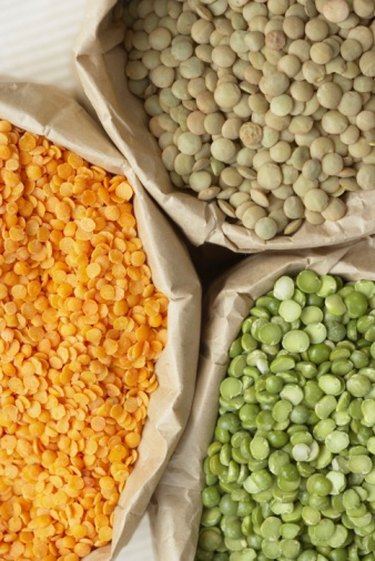
Quick-cooking lentil beans, a type of legume, are easy to prepare and packed with protein, fiber and other essential nutrients. They are primarily produced and consumed in Africa, India, China, Syria, Turkey and the Middle East and readily absorb the flavors of a variety of spices, herbs and other seasonings.
Identification and Types
Video of the Day
Lentils are small, round-, oval- or heart-shaped legumes, or the seeds of leguminous plants botanically named lens ensculenta. Commonly identified by their color, lentils come in a wide variety, including green, brown, black, yellow, red, orange, pink and white. Green and brown are the most common lentils grown and eaten in the U.S.. In general, lentils have a hearty, somewhat nutty flavor, though flavor may differ slightly among varieties. Lentils are sold whole and skinned or not skinned, split and not skinned or split and skinned, which are called "dal."
Video of the Day
Nutrition
With almost 18 gm of protein per cup, lentils are a good source of protein for vegetarians and vegans or for non-vegetarians seeking an alternative, low-fat source of protein. Also known for their high dietary fiber content, both insoluble and soluble, lentils contain 15 gm of fiber per cup. Lentils also contain 7 gm of energy-producing, metabolism-improving iron per cup. Other essential vitamins found in lentils include potassium, folate, magnesium and a variety of B vitamins.
Health Benefits
When eaten regularly, the high fiber content in lentils may help lower cholesterol and manage blood sugar disorders, such as hypoglycemia and diabetes, by balancing blood sugar levels and providing you with slow-burning energy. Insoluble fiber, in particular, not only improves digestion and intestinal regularity but may help prevent digestive disorders, such as irritable bowel syndrome and colon cancer. Upon regular consumption, the combination of fiber, folate and magnesium in lentils also contributes to a healthy heart and may help prevent heart disease.
Storage and Preparation
Dry lentils will keep for up to one year when stored in an airtight container in a cool, dry place while cooked lentils will keep for three days when refrigerated in a covered container. You do not need to soak lentils before cooking, but you do need to check for, and remove, any stones and debris before rinsing them under cool, running water. To cook, boil 3 cups of water per cup of lentils and place lentils in the water when it comes to a boil, then reduce heat, cover and allow to simmer for 20 to 30 minutes. Cooking times may vary, depending on the type of lentil and the desired texture. For firmer lentils, cook for five to 10 minutes less than the usual cooking time and for softer lentils, cook for 10 to 15 minutes longer. If you are seasoning lentils with salt or acidic ingredients, add these last or they will slow down the cooking process. Lentils are best when seasoned with herbs and spices with assertive flavors. Serve lentils with rice or other grains, in salads or soups or pureed into a soup.